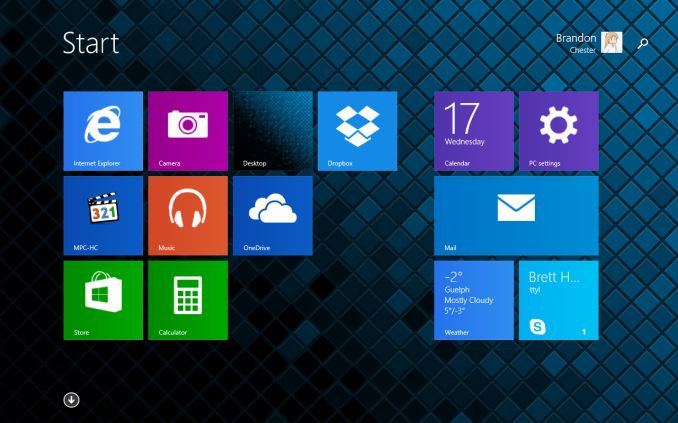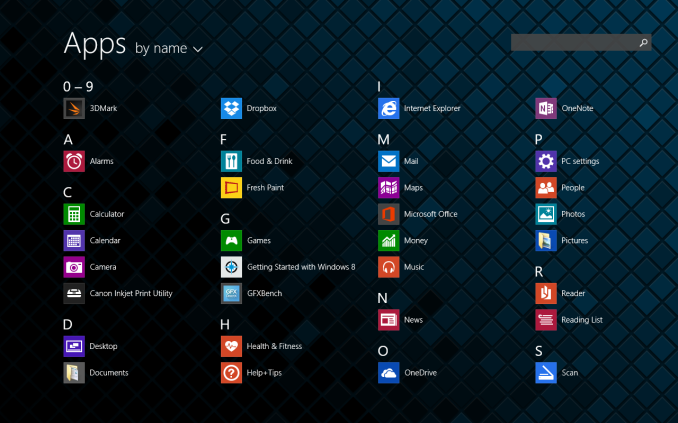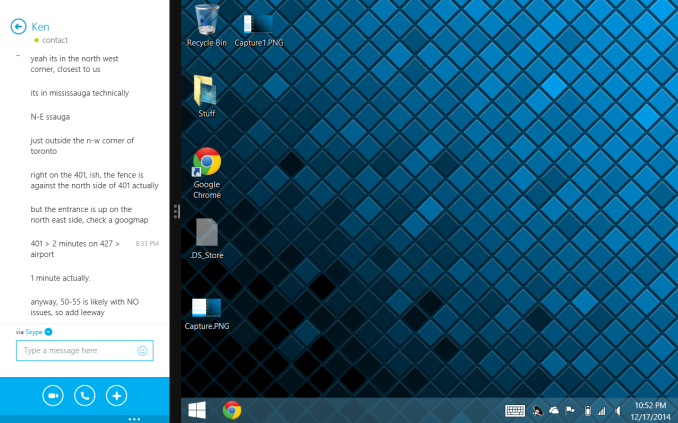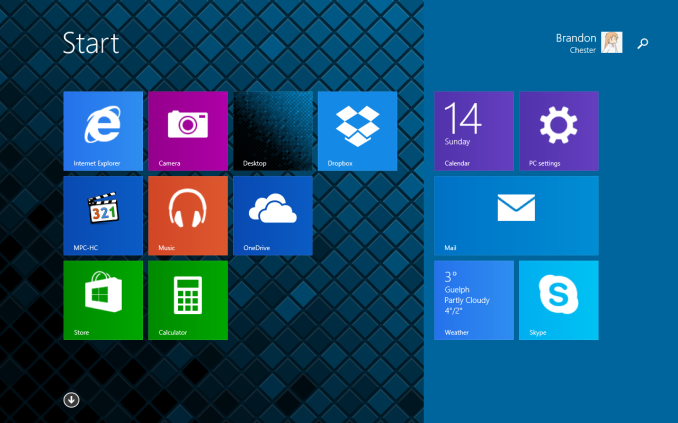HP Stream 7 Review: A $119 Windows Tablet
by Brandon Chester on December 19, 2014 8:00 AM ESTWindows On Tablets
It's sort of interesting how the Windows tablet experience is unknown to many people. I stated earlier that there's more of a focus on Android and iOS tablets than Windows ones. In fact, the Windows 8 experience in general is unknown to many people. Although Windows 8 was released over two years ago, it still hasn't gained significant adoption among Windows users, myself included. This means that the Stream 7 was actually my first real experience with Windows 8, used primarily with a touch interface and in the Modern UI.
Like many people, I don't feel that the Modern UI is well suited to desktops and laptops, and is aimed more at tablets. Since the Stream 7 is a tablet, I hoped that Windows 8 would be able to provide a good experience, as the alternative was accepting that Modern isn't really good on anything. The HP Stream 7 runs Windows 8.1, but I will refer to is simply as Windows 8 as 8.1 is a free upgrade much like service packs in older versions of Windows.
The Stream 7 can be used in both landscape and portrait orientations, and what's interesting is that unlike a 7" Android tablet where I feel compelled to use it in portrait mode, I prefer to use the Stream 7 in landscape. This may have something to do with Windows feeling more natural in landscape because of my experience using it on desktop and laptop computers that have widescreen monitors.
The big change for many users when going from Windows 7 to Windows 8 is the new full screen Start Screen that replaced the Start Menu from previous versions of Windows. The Start Screen is an area you will be spending a lot of time in when you use a Windows tablet. When you use Windows 8 on a traditional computer, many people use something like Start8 or Classic Shell to get back the old style Start Menu. Even if you aren't, you'll be spending a lot of time on the desktop. On tablets, the Start Screen is analogous to the home screen on iOS and Android, but it's more similar to Android's launcher implementation. It's a way to access all your full screen Modern UI applications, and so unlike a PC where you spend your time on the desktop, you spend your time on the Start Screen when you're not using an application on your Windows tablet.
Swiping down or tapping the arrow in the bottom left of the Start screen brings you to the Apps Screen. This is a list of every application on the device and it replaces the "All Programs" section of the old Start Menu. You can see most of the default applications above, along with a few that I've installed. Windows 8.1 seems to come with most of the applications that you would expect to have by default on a tablet, and it even has some like a Calculator that Apple hasn't thought to include on the iPad after six generations.
Some good news about bloatware is that when you purchase the Stream 7 from Microsoft's store there isn't really any. Windows Signature Edition doesn't come with any 30 day antivirus trials, or manufacturer software to do things that Windows already does. (This is a good thing, as running a bunch of extra software on a 1GB Windows tablet would be truly problematic.) There are a couple of applications from HP relating to support documentation and registering your warranty, but these can be deleted and they only take up a few hundred megabytes. On that note, the Stream 7 comes with a bit under 19GB free out of the box, and I'll talk about storage management in a moment.
I think the split screen feature is an area where Microsoft is ahead of the competition by a large margin. The iPad has nothing that compares to this, and the multi-window support on some of Samsung's tablets is not implemented as well. Microsoft allows you to place two apps side by side, and the size of each can be adjusted by moving the bar that separates them. You can even put Modern UI applications next to the Windows desktop, which is a neat feature that you can see demonstrated above.
I think the implementation is a bit unintuitive though. To access it, you need to open your open applications by dragging in from the left, and then dragging back. This is a horrible gesture, because it's swiping somewhere and then reversing it, which would imply that the result is no change at all. Once you figure that out, you then drag your second application from the list and place it next to the one you currently have open. When you get the hang of it, it becomes very easy, but when I was first getting used to the tablet I found myself doing it by accident.
Unfortunately, the experience isn't without its issues. One of the things I've found difficult is managing storage. On an iOS or Android device, most of your files are stored within an application's container, so it's easy to manage storage by simply looking at how much space applications and their documents are taking up. Windows is more complicated, as it's a complete desktop operating system with a file system that users are intended to interact directly with on a regular basis.
When I add up all the space taken up by applications, documents, etc. in the storage section of the settings app, there is still space that is being used that I cannot easily trace. It can be difficult to keep track of every saved photo, video, document, etc. when they're not all forced into a specific application's storage location, and I suspect there are also hidden folders like Appdata with files taking up space from applications I have uninstalled. This problem applies more to desktop Windows applications than Modern UI ones, but it's worth noting because I think other users will end up having to deal with this as well.
I've also encountered a few annoying software issues. One that occasionally pops up is what you see above, where there seems to be some issue with rotating my wallpaper that leads to a large area that matches the accent color I've chosen. I've tried to fix this by using different wallpaper dimensions, such as a native 1280x800 image, and a 1280x1280 image that should fit along the tablet's longest axis in any orientation, but it still seems to occur. Simply resetting the wallpaper or rebooting usually fixes the problem but it's worth pointing out. There are also times where applications or the interface itself will stop responding, which can be frustrating; it can be a painful reminder that you're running Windows.
As for the applications on the Windows Store, the experience ranges from good to really, really bad. Most of Microsoft's applications are very good, as expected. There are also third party apps like Dropbox that are just as good as on other platforms. But those seem to be exceptions to what I see as the theme in the Windows Store where applications fit into one of three categories:
- The app you want doesn't exist at all, with no first or third-party option.
- A first-party app exists, but it's either outdated compared to other platforms or just not as good.
- A third-party app exists, but it's missing features or doesn't perform well.
This is a serious issue, and at this point I honestly don't know how Microsoft can resolve it apart from trying to bribe developers. Twitter is a great example of an application that exists but is not as good as the version on iPad by any measure. I can't fault HP or the Stream 7 for this, but it is running Windows and it's a problem that will affect them even more than it affects Microsoft.
While there are tons of legacy Windows applications out there, the touch experience in the traditional Windows desktop interface is not very good. I find things difficult to tap, it's hard to fit Windows on the screen, and applications simply don't look or run as well as Modern UI ones.
This brings us to a very confusing situation regarding Microsoft Office. The Stream 7 includes 1 year of Office 365 with one PC license, one tablet license, and one smartphone license. The problem is, Microsoft doesn't have a touch optimized version of Office for Windows like they do for the iPad. Unless you hook up a Bluetooth mouse and keyboard, it's really hard to use the desktop Office client on a Windows tablet.
To me, this represents an oversight in Microsoft's product planning. The iPad is by far the dominant tablet in terms of usage share, and so it would make sense to target it due to the potential customers available. However, it means that Microsoft has prioritized another platform over their own. This does absolutely nothing to help the troubles that Windows 8 is facing. If Microsoft isn't going to make their own platform a priority, how can developers be expected to do so? Similarly, if Microsoft isn't going to support their platform, why should customers adopt it? By the time Windows 10 rolls around, Microsoft needs to improve the touch experience in the Windows desktop interface, and they need to make a touch optimized version of Office for the Modern interface.
Overall, Windows on tablets is something of a mixed bag. The interface translates better from PCs to tablets than I expected, and there are some well implemented features like split-screen multitasking, but there's still a lot of work to be done. Microsoft needs to improve the application selection quickly, and improved touch support definitely needs to be a priority.














157 Comments
View All Comments
mkozakewich - Wednesday, December 24, 2014 - link
I've been waiting for this for almost five years. I got a refurbished $200 netbook in the beginning of 2010, and then a $600 pocket netbook (Viliv N5) half a year later, and then a new $200 netbook near the end of 2011. This basically beats all of those, and at half the price.Evaluate - Monday, December 29, 2014 - link
I bought HP stream 7 tablet and I am fully satisfied with its unbeatable productivity and performance compared to android tablets.I have used android devices for a while and now having HP stream 7 tablet in my hand for $100 it sounds unbelievable. In android devices either smartphone or tablet your productivity is limited badly. Here in HP stream 7 tablet you can enjoy full windows and can install all software. You don't need to accept any limitation as you can find countless alternative software if one wasn't good enough. Full Microsoft office, you cannot compare it with any toy software in android. You might spend $340 for Samsung Galaxy that runs android and you might gradually make yourself happy with whatever it gives you.
I am very much impressed that I could run full windows and programming applications, unbeatable performance in playing videos and all these just for $100. I am really impressed.
Android might be good for smartphone as the functionality is OK for phoning. However if you want to find, install and use anything else seriously, forget it.
Don Gateley - Sunday, January 4, 2015 - link
Sorry to hear about the poor audio jack. The one thing this device and the more expensive Dell VENUE Pro 8 Win 8.1 tablet offer that you can't get with any Apple or Android tablet is the ability to process any audio passing through it from any source on the way to the jack or to Bluetooth.I have an app that uses that capability which will make the cost of the device unimportant. The function alone will justify the cost. The Dell device has the DSP horsepower needed and I'll have to see if this one does even if it isn't yet a good platform for my app for electronic reasons.
thebeephaha - Monday, January 5, 2015 - link
AnandTech / Brandon Chester - Have you thought about reviewing the Plugable Pro8 docking station that was a Kickstarter earlier this year? Now it's up on Amazon and is designed for the HP Stream 7 (and several other small Windows tablets) to both charge and provide USB device connectivity at the same time.http://plugable.com/products/ud-pro8
Looking at the reviews, it should basically turn the Stream 7 into a much more capable little system.
mister qwik - Friday, January 23, 2015 - link
interesting nice read. using the hp gave a win8 education and it boots faster than my 2 samsung and asus tabs. a blutooth ms mouse fixes finger poking. a lenmar helix powercell fixes power worries. useful items for any tablet sit down session. for any oddities as mentioned the price was right or i wouldn't have one.junipers - Friday, May 5, 2017 - link
It's 2017/5/4. I've had the HP Stream 7 for a year and it's been interesting. In the beginning it was little more than proof of concept. Windows 10 ran but it was a device plagued by hardware compatibility problems. Microsoft and its partners have done quite an impressive job in tracking down and rooting out hardware bugs. Hibernate/Sleep now preserve battery life for weeks on end. Recently the wifi connection became stable. Even certain aspects of Windows like Edge have become subtly more usable (though, Edge is still the epitome of mediocrity in terms of details like a non-functional Find and many web pages which don't work properly).The HP Stream 7 with Windows 10 is still nowhere near as usable as similarly spec'd Android or iOS device, but, it is functional in a pinch if you need to run older Win32 apps in a super portable device. I've run SketchUp and Excel to view documents, and, if you add a BT keyboard and mouse and you've got a super-portable MS Word word processor or PowerPoint designer.
For a lark I put Halo: Spartan Assault on and it runs swimmingly. The only thing wrong with the game and the tablet is Windows 10 and how Microsoft cannot figure out how to disable edge swipes when the game is in full screen mode <droll laugh>.
Windows 10 has improved since I first got the tablet a year ago. After recently doing a Fresh Start the OS runs a relatively lean 14.5 GB with 2.8 GB worth of apps (1 GB for Halo: Spartan Assault). There's still over 11.2 GB free. 300 MB of the 2.8 GB are the Mobile Word, Excel and PowerPoint, and, since it's a 7" tablet, those three are FREE edit-enabled versions even if you don't have an Office 365 subscription. They're not as full-featured as real Office, but, in a pinch they'll do.
MarkWebb - Wednesday, February 6, 2019 - link
It's Feb 2019 and the original wave or Win tablets are still running - the Stream 7/8, Winbook 7 and 8, the Venue 8. I've got some observations as a long-time owner (but only occasional user) of each of these devices:1. HP blew it on the audio. The static crackle is still there. But now Mpow bluetooth earbuds only run about $18 on Amazon, so there's that. I even got a warranty replacement on the Stream 7 and it came back with the same static. It's not a constant, there are moments of audio clarity then the static kicks in.
2. Windows 10 version 1809 is superb on these little tablets. About 16gb free on a 32gb version (only Dell offered 64gb versions). I had to wipe out the old factory recovery partitions and do clean installs.
3. Driver support on Dell is awesome with occasional driver updates over the years and even includes Dec 2018 BIOS updates (Spectre Meltdown etc.). HP has drivers on their web page, but NO updates since 2015. Winbook you have to email MicroCenter for a "secret" link to drivers. Nuvision also lacks support.
4. Running on 1gb on 32bit is like having hair transplants without local anesthetic. Consider this a "one app at a time" device and since Chrome opens instances for each new tab, consider limiting to just Facebook, just USA Today if you open tabs on those demanding web pages.
5. 2gb on 32bit is faster than a netbook of yore, slower than a Chromebook on an ARM chip or an N3xxx processor. So, adequate. What 2gb/32bit lacks in speed, it makes up for in running 720p (and downconverting 1080P) H264 files, with subtitles, just fine. But not when downloading Patch Tuesday in the background! MPC-HC will handle the more stubborn files, the built in Windows player app can handle almost everything smoothly and has a better interface, and VLC is sort of ok.
6. 4gb on a 64bit machine is like 2gb on a 32bit machine. What you gain in RAM you lose due to the extra demands of 64bit. So don't complain if your tablet "only" runs 32bit, it might be better performing.
7. Dell Venue 8 Pro is limited to about 79% gamut BUT the color is very accurate. The HP Stream 7 is pretty terrible and is downright unusable unless you go into Control Panel, Display, and "calibrate" sop everything isn't lost in shadows during playback. The colors still seem weird after, but at least you don't feel like you are in a dark room without a flashlight.
8. If you get used to the 2gb/64gb Dell Venue 8 Pro and then try the later, supposedly improved (but actually just cheaper) successor the 1gb/32gb Dell Venue 8 Pro, you will be able to measure the additional delays due to the retrench to 1gb with a hourglass - no stopwatch required. It is so slow sometimes I think it crashed. It WILL play Netflix, Amazon Prime, and run h264 just fine though. So long as it isn't Patch Tuesday.
9. Don't mistake the puny 8" tablets with the fine Dell Venue 10 Pro (whether 720p with Bay Trail, 1080p with Bay Trail, 1080p with Cherry Trail and 4gb/128gb) which has a faster clock speed. Or with the Venue 11 Pro which is a mishmash of 2gb or 4gb, 32bit and 64bit, N3775 and N3795. All reportedly about 80% gamut. With the Dell Venue Pro 11 7140 they shot up to 100% color gamut and entry level was a Core M3, optional M5 and then i3 etc. IIRC. The Latitude 11 was born great, great screen and good Core M.